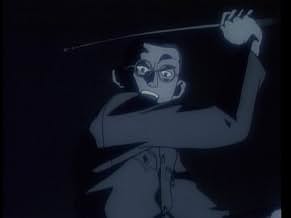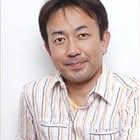Peacock King: Harvest of the Cherry Blossoms
Original title: Kujaku ô 3: Ôka hôjô
- Episode aired Sep 21, 1991
IMDb RATING
6.4/10
13
YOUR RATING
- Director
- Writer
- All cast & crew
- Production, box office & more at IMDbPro
Storyline
Did you know
- TriviaMakoto Ogino: Creator of the "Kujaku-O" manga, voices Putaro.
Featured review
A HARVEST OF CHERRY BLOSSOMS (1991), the third OAV (Original Animation Video) installment in the PEACOCK KING series of occult thrillers, is quite a bit different in tone and setting from the four others in the series and achieves different results. Set predominantly in the island mansion of a reclusive former Japanese movie star, the piece starts out more along the lines of a haunted house/mystery style horror film before bringing on, in its final third, the standard dark gods/revived spirit motifs of the traditional occult thriller. This entry in the series continues the practice of invoking Japanese historical figures, in this case one Lady Yomi (not named in the English dub but simply defined as "the mistress of the underworld," a 16th century opponent of Ieyasu Tokugawa, after whom the Tokugawa Shogunate was named). However, it also takes the bold step of implicating the American postwar military occupation.
The elusive central figure in the case is Setsuko Ohara, a onetime movie goddess in Japan who went into seclusion after 1948. Flashbacks reveal a guilt-ridden affair with an army commander (the commander of the American occupation army according to a fan-subtitled version of the Japanese original, but simply identified as the "army commander" in the English dub). A Japanese officer hopes to use Setsuko to kill the commander and enable a coup to restore the Imperial regime. When the bloody deed is done, however, evil spirits are unleashed and cause a number of disastrous incidents to affect the Japanese people. Setsuko goes into hiding while the Japanese officer becomes a Catholic priest.
A TV crew, led by female producer Saeko Ninomiya, descends on Setsuko Ohara's island home accompanied by our heroic team of spirit warriors, Kujaku, the reincarnated Peacock King; Ashura, his cute sidekick; and Onimaru, the biker/spirit mercenary of forbidden curses. We soon learn that Setsuko, a powerful medium in her own right, is possessed by the spirit of Lady Yomi who seeks to murder seven psychics to avenge an injustice done to her some 400 years earlier. By the time the TV crew lands, two psychics have already been killed in an earlier, related TV stunt and the remaining five are on hand, including our three heroes; the guilt-stricken Father Takahata, the onetime Japanese officer; and Setsuko herself. It is eventually revealed that Lady Yomi's ultimate mission is to inflict madness on Japan in revenge for the wrongs done her. The final battle takes place aboard a huge spirit ship that had carried Lady Yomi to her death at sea.
It's all somewhat difficult to sort out, especially given the differing versions of events offered by the principals. Kujaku insists that Lady Yomi sought to bring chaos to Japan during the era of Warring States, while Tokugawa defeated her using the powers of the great spiritualists of Japan at the time. The "Seven Deities" sealed up the Lady in a ship and set out to sea. Setsuko found the ship on Onibi Island and sought to revive Lady Yomi so she could absorb her power. When disaster befell Japan, she attempted to seal up the spirit and the seven deities by going into seclusion on the island.
However, the TV producer, Ninomiya, offers a somewhat contradictory, vaguely feminist account of the tale. She claims that Yomi had been used and discarded by Tokugawa and that the Seven Deities had protected her and kept her spirit alive in a treasure ship all these years until Setsuko Ohara found the ship. Having also been abused by authority, Setsuko was sympathetic to Lady Yomi and tried to create a peaceful resting place for her soul. Neither she nor Yomi wanted to unleash a curse, but Yomi's desire for life turned into a curse and started to destroy Setsuko's body, forcing her seclusion and retirement from the world.
The overplotting doesn't exactly allow for the kind of pure psychic thrills served up so spectacularly in Volumes 1 (FESTIVAL OF OGRES' REVIVAL) and 2 (CASTLE OF ILLUSION). It offers a similar level of bloody violence (more than Vol. 1, but less than Vol. 2), but also pumps up the sexual content and includes sex scenes involving Setsuko and the army commander and one involving the TV producer being stripped nude and thrown up against a wall in the mansion and violated by an invisible entity. It's still a fascinating entry in the series, but one that's a bit more demanding and, ultimately, less exciting than the others.
Curiously, the name Setsuko Ohara recalls that of famed Japanese actress Setsuko Hara (still living as of this writing, according to IMDb), who worked for Japan's greatest directors and was a favorite of both Akira Kurosawa and Yasujiro Ozu. The character of Ohara is seen only in photos and flashbacks and resembles Setsuko Hara in one or two shots only, but the character does not appear to have been based on the real actress who retired in 1962.
The Peacock King franchise would get picked up again in 1994 for a spectacular two-part version called PEACOCK KING: SPIRIT WARRIOR, also reviewed on this site.
ADDENDUM (March 27, 2015):Thirteen years after writing the above review, I came across a relevant tidbit in a book called "The China Lover," by Ian Buruma, a novel about the actress Shirley Yamaguchi. Part 2 of the book is narrated by an American film buff working in Japan during the Occupation, a character based on film historian Donald Richie, and he makes reference to a rumor that Setsuko Hara (cited above), the "eternal virgin" of Japanese film lore, had an affair with an American military officer during the Occupation. That officer is named Colonel Wesley F. Gunn in the book, although I believe that the name is fictional. This is the only place I've come across this rumor, but I'm guessing the writer of this episode of "Peacock King" heard that rumor as well.
The elusive central figure in the case is Setsuko Ohara, a onetime movie goddess in Japan who went into seclusion after 1948. Flashbacks reveal a guilt-ridden affair with an army commander (the commander of the American occupation army according to a fan-subtitled version of the Japanese original, but simply identified as the "army commander" in the English dub). A Japanese officer hopes to use Setsuko to kill the commander and enable a coup to restore the Imperial regime. When the bloody deed is done, however, evil spirits are unleashed and cause a number of disastrous incidents to affect the Japanese people. Setsuko goes into hiding while the Japanese officer becomes a Catholic priest.
A TV crew, led by female producer Saeko Ninomiya, descends on Setsuko Ohara's island home accompanied by our heroic team of spirit warriors, Kujaku, the reincarnated Peacock King; Ashura, his cute sidekick; and Onimaru, the biker/spirit mercenary of forbidden curses. We soon learn that Setsuko, a powerful medium in her own right, is possessed by the spirit of Lady Yomi who seeks to murder seven psychics to avenge an injustice done to her some 400 years earlier. By the time the TV crew lands, two psychics have already been killed in an earlier, related TV stunt and the remaining five are on hand, including our three heroes; the guilt-stricken Father Takahata, the onetime Japanese officer; and Setsuko herself. It is eventually revealed that Lady Yomi's ultimate mission is to inflict madness on Japan in revenge for the wrongs done her. The final battle takes place aboard a huge spirit ship that had carried Lady Yomi to her death at sea.
It's all somewhat difficult to sort out, especially given the differing versions of events offered by the principals. Kujaku insists that Lady Yomi sought to bring chaos to Japan during the era of Warring States, while Tokugawa defeated her using the powers of the great spiritualists of Japan at the time. The "Seven Deities" sealed up the Lady in a ship and set out to sea. Setsuko found the ship on Onibi Island and sought to revive Lady Yomi so she could absorb her power. When disaster befell Japan, she attempted to seal up the spirit and the seven deities by going into seclusion on the island.
However, the TV producer, Ninomiya, offers a somewhat contradictory, vaguely feminist account of the tale. She claims that Yomi had been used and discarded by Tokugawa and that the Seven Deities had protected her and kept her spirit alive in a treasure ship all these years until Setsuko Ohara found the ship. Having also been abused by authority, Setsuko was sympathetic to Lady Yomi and tried to create a peaceful resting place for her soul. Neither she nor Yomi wanted to unleash a curse, but Yomi's desire for life turned into a curse and started to destroy Setsuko's body, forcing her seclusion and retirement from the world.
The overplotting doesn't exactly allow for the kind of pure psychic thrills served up so spectacularly in Volumes 1 (FESTIVAL OF OGRES' REVIVAL) and 2 (CASTLE OF ILLUSION). It offers a similar level of bloody violence (more than Vol. 1, but less than Vol. 2), but also pumps up the sexual content and includes sex scenes involving Setsuko and the army commander and one involving the TV producer being stripped nude and thrown up against a wall in the mansion and violated by an invisible entity. It's still a fascinating entry in the series, but one that's a bit more demanding and, ultimately, less exciting than the others.
Curiously, the name Setsuko Ohara recalls that of famed Japanese actress Setsuko Hara (still living as of this writing, according to IMDb), who worked for Japan's greatest directors and was a favorite of both Akira Kurosawa and Yasujiro Ozu. The character of Ohara is seen only in photos and flashbacks and resembles Setsuko Hara in one or two shots only, but the character does not appear to have been based on the real actress who retired in 1962.
The Peacock King franchise would get picked up again in 1994 for a spectacular two-part version called PEACOCK KING: SPIRIT WARRIOR, also reviewed on this site.
ADDENDUM (March 27, 2015):Thirteen years after writing the above review, I came across a relevant tidbit in a book called "The China Lover," by Ian Buruma, a novel about the actress Shirley Yamaguchi. Part 2 of the book is narrated by an American film buff working in Japan during the Occupation, a character based on film historian Donald Richie, and he makes reference to a rumor that Setsuko Hara (cited above), the "eternal virgin" of Japanese film lore, had an affair with an American military officer during the Occupation. That officer is named Colonel Wesley F. Gunn in the book, although I believe that the name is fictional. This is the only place I've come across this rumor, but I'm guessing the writer of this episode of "Peacock King" heard that rumor as well.
- BrianDanaCamp
- Aug 7, 2002
- Permalink
Details
- Release date
- Country of origin
- Language
- Production company
- See more company credits at IMDbPro
- Color
Contribute to this page
Suggest an edit or add missing content









